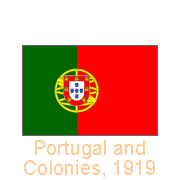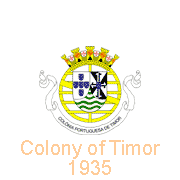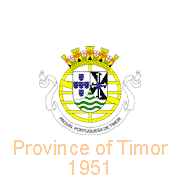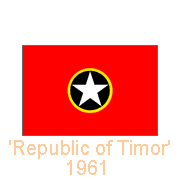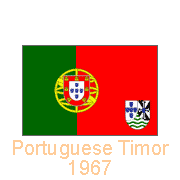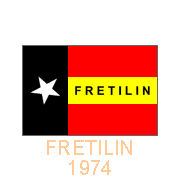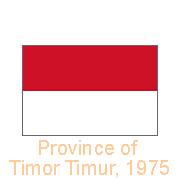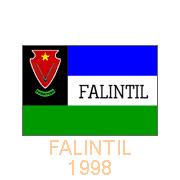Flags from Timor-Leste
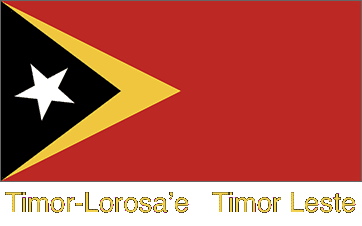
A Flag history of Timor-Leste
East Timor was a Portuguese colony for four centuries, but it never passively accepted colonial rule. There were large uprisings between 1860 and 1912 against the Portuguese, who wanted to tax the Timorese. In 1895 Boaventura, the “Liurai” or local ruler of Manufahi, united other Timorese leaders against the Portuguese and led them for 16 years against the colonists.
you may then send it as a postcard if you wish.
The Rebellion of Manufahi was eventually crushed in 1911/12 with Portuguese troops, shipped in from Mozambique and Angola. It is estimated that more than 3,000 people were killed and many thousands more taken prisoner. The last large rebellion took place in 1959 in Viqueque and it was put down with great brutality by the Portuguese: around 1000 people were killed. In early 1961 the leftist “Battle Office for the Liberation of Timor” (Bureau de Luta pela Libertação de Timor) under the leadership of Maoclao and with financial backing by Indonesia was formed. It proclaimed a republic in the border town of Batugade on 9 April 1961 and appointed a government with 12 ministers. The Portuguese quickly crushed the rebellion, and the participants fled to Indonesia. In 1963, while in exile in Indonesia, Maclao proclaimed the United Republic of Timor and hoisted the same flag. Nothing came of it, and the attempt was abandoned with Maclao going to live in London.
The green and red flag of Portugal had been adopted on 5 October 1910 when a revolution overthrew the monarchy and Portugal became a republic. This flag was the only one used in Portugal’s “Overseas Provinces”, including Portuguese Timor. In 1967 a design for a distinct emblem for Portuguese Timor was approved, a Portuguese flag with the colonial coat of arms on the lower fly. However, it didn’t come into effect, and the flag was never hoisted. In 1974 the “Carnation Revolution” took place in Portugal and it became clear that Portugal would abandon its colonies, including East Timor. A number of political parties were formed, like the conservative UDT (União Democratica Timorense, Timorese Democratic Union), the Pro-Indonesian APODETI (Associação Popular Democrática de Timor, Popular Democratic Association of Timor), a party founded on 27 July 1974 in support of “autonomous integration into the Republic of Indonesia based on international law”) and FRETILIN (Frente Revolucionária de Timor-Leste Independente, Revolutionary Front for an Independent East Timor). This was the liberation movement that, from 1974 to 1998, fought for the independence of East Timor, first against Portuguese colonial rule and then against the Indonesian occupation. Its flag was inspired by the flag of Maclao’s still-born Republic in 1961 and later on became the basis of the National flag.
Following a coup in Dili on 11 August 1975 by members of the conservative UDT a brief civil war broke out between UDT and FRETILIN in which the latter prevailed and on 28 November 1975 declared independence. A national flag was adopted, clearly based on that of FRETILIN. However, Indonesia invaded the country on 7 December 1975 and in July 1976 formally made East Timor its 27th province, a move never recognised by the United Nations. The only flag now allowed was the “Merah-Puti” (red and white) national flag of Indonesia.
FALINTIL (Forças Armadas da Libertação Nacional de Timor-Leste, Armed Forces for the National Liberation of East Timor), the military wing of the FRETILIN political party, was established on 20 August 1975 during the conflict with the UDT. During the first East Timorese National Convention, held in April 1998 in Portugal, a new flag was adopted by representatives of the Timorese political parties and organisations. Originally it was the flag of FALINTIL because, being non-partisan, it represented the interests of all people and not of any specific organisation. And, as FALINTIL members continued the struggle for independence, it was decided to adopt this flag as a temporary national flag of East-Timor. Following the announcement that a referendum on independence from Indonesia would be held, a new flag was hoisted in Dili on 15 August 1999. The CNRT (Conselho Nacional de Resistência Timorense, National Council of Timorese Resistance) was an assemblage of nearly all the Timorese groups, excluding only the integrationists of APODETI. The flag was the same as that of FALINTIL (with “CNRT” instead of “FALINTIL” on the white stripe) and regarded as the new national flag by the independentists.
But after the overwhelming victory of FRETILIN in the parliamentary elections, the constitutional assembly restored all the symbols adopted when, in 1975, independence had been proclaimed. The new flag, now with proportions of 1:2 (although this is not prescribed and 3:2 can still be seen), was first raised on 20 May 2002 at the nation’s independence celebrations and remains the national flag of Timor-Leste.


